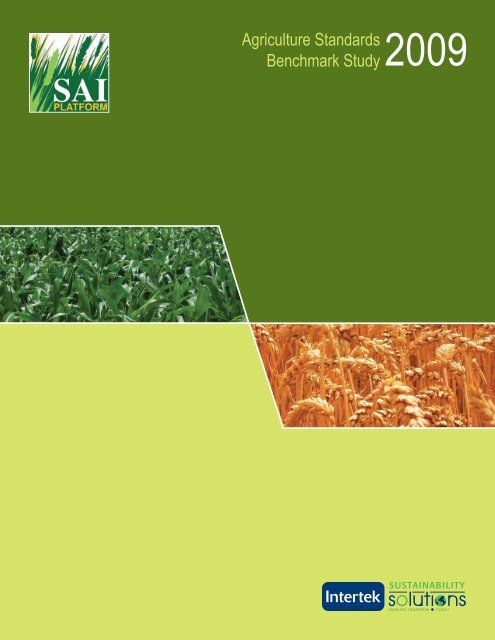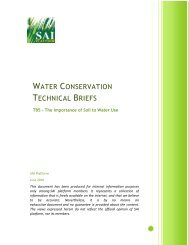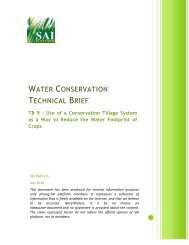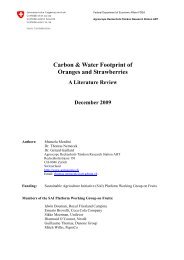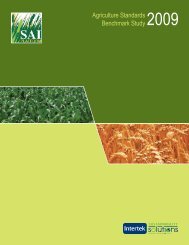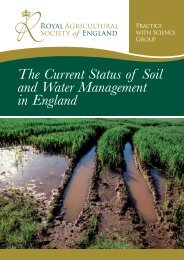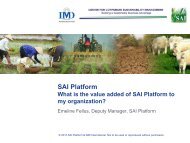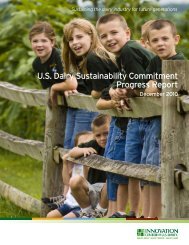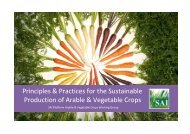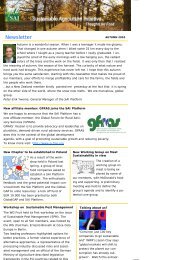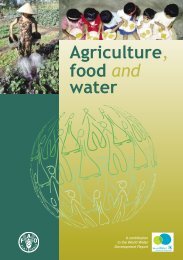DETAILED BENCHMARK ANALYSIS - SAI Platform
DETAILED BENCHMARK ANALYSIS - SAI Platform
DETAILED BENCHMARK ANALYSIS - SAI Platform
You also want an ePaper? Increase the reach of your titles
YUMPU automatically turns print PDFs into web optimized ePapers that Google loves.
<strong>DETAILED</strong> <strong>BENCHMARK</strong> <strong>ANALYSIS</strong><br />
Agriculture Standards Benchmark Study | 2009
Published July 2009<br />
Study commissioned by Sustainable Agriculture Initiative (<strong>SAI</strong>) <strong>Platform</strong><br />
CONTACT INFORMATION<br />
43 avenue des Arts<br />
1040 Brussels<br />
Belgium<br />
Tel. +32 (0)2 500 87 57<br />
info@saiplatform.org<br />
Long before the recent surge in food prices, three of the largest food producers in the world, Danone, Nestlé and Unilever, recognized that<br />
sustainability is critical to secure a constant, growing, and safe supply of agricultural raw materials. The companies came together in 2002<br />
to found The Sustainable Agriculture Initiative (<strong>SAI</strong>) <strong>Platform</strong>—a non-profit organization dedicated to actively supporting the develop-ment of<br />
sustainable global agriculture practices involving all stakeholders of the food supply chain.<br />
The <strong>SAI</strong> <strong>Platform</strong> today includes 21 corporate members, with estimated sales of USD 300 billion, which actively work to promote sustainable<br />
agriculture as a productive, competitive and efficient way of producing agricultural products, while at the same time protecting and improving<br />
the natural environment and social/economic conditions of local communities.<br />
www.saiplatform.org<br />
Written by Intertek Sustainability Solutions<br />
CONTACT INFORMATION<br />
254 W. 54th St, 13th Floor<br />
New York, NY 10019<br />
U.S.A.<br />
Tel: +1-212-803-5300<br />
customerservices@intertek.com<br />
6, Avenue Marceau<br />
75008 Paris<br />
France<br />
Tel: +33 (0)1 56 90 24 63<br />
customerservices@intertek.com<br />
Intertek Sustainability Solutions (ISS) works with businesses to seamlessly integrate CSR and Sustainability with their brand and operations.<br />
We are proficient in delivering solutions dealing with immediate environmental and social concerns, but our ultimate value for clients has proven<br />
to be our ability to develop a portfolio of initiatives that align social and environmental performance with business imperatives for maximum<br />
Return on Sustainability Investment (RSI).<br />
Specifically, we:<br />
• Design sustainability strategy, tailored to client needs and utilizing a variety of techniques – such as corporate risk/opportunity profiling,<br />
benchmarking, gap analysis and assessment of sustainability reporting and communications efficacy.<br />
• Deploy cost-effective and materially-relevant sustainability programs for our clients, including audits and inspections of client and<br />
supplier facilities, certifications of compliance with a variety sustainability schemes and standards, as well as training, capacity building,<br />
remediation and continuous improvement programs.<br />
• Provide key industry-leading CSR/Sustainability solutions and tools
TABLE OF CONTENTS<br />
Introduction 2<br />
Master list of standards reviewed 4<br />
Benchmark content and coverage protocol 6<br />
High level benchmark charts 8<br />
Detailed benchmark analysis 10-57<br />
Whole Farm Sustainability 10-31<br />
Crop specific 32-41<br />
Organic 42-47<br />
Food Safety 48-57<br />
Index 58<br />
Agriculture Standards Benchmark Study | 2009
INTRODUCTION<br />
The Agriculture Standards Benchmark Study was commissioned by <strong>SAI</strong> <strong>Platform</strong> with the aim of investigating and comparing<br />
some of the most influential agricultural production standards worldwide. The objective of the study is to give <strong>SAI</strong><br />
<strong>Platform</strong> members further insight into the various agriculture schemes in order to facilitate sustainable sourcing. This study<br />
can be utilized in a procurement context as a tool for answering initial questions that arise as one seeks the best and most<br />
appropriate method to ensure sustainably produced agricultural raw materials.<br />
• DEMONSTRATION OF GOOD GOVERNANCE: How does each standard compare in terms of their development in<br />
an inclusive basis and the degree to which they are properly managed and controlled?<br />
Some standards are more transparent than others with regard to the Governance and Regulation criteria<br />
evaluated for this study. Having a proper level of public transparency in this area provides a solid foundation<br />
for demonstrating effectiveness and longevity in support of the growing need for first-rate agriculture<br />
standard programs.<br />
• DEMONSTRATION OF GOOD PRACTICES: How does each standard compare in employing good practical<br />
elements that work to enhance the performance of the farm?<br />
The Systems Enhancement Criteria evaluated in this study are based solely against the criteria laid out in the<br />
standards themselves. It does not include every aspect or encompass the entire range or broad intentions of<br />
offerings that may be available through each scheme.<br />
• EQUITABLE STANDARDS: How does each standard relate to the framework of the <strong>SAI</strong> <strong>Platform</strong> Principles?<br />
The <strong>SAI</strong> <strong>Platform</strong> Principles Comparison is based on the principles/criteria that compose the content of each<br />
of the standards. It is directly related to the guidelines or requirements laid out for the suppliers to adhere to.<br />
• AVAILABLE MODELS: Is the agriculture standard a certification or verification scheme, or simply a framework?<br />
The different schemes compared in the benchmark study have not been developed with the same intentions<br />
and with the same national / regional applicability. The different schemes address either whole farm<br />
approaches or crop-specific procedures; tackle mainly issues of food safety or even particular production<br />
schemes such as organic. The rationale for including a wide variety of scheme types is that many<br />
suppliers participate in multiple programs, none of which covers the full <strong>SAI</strong> <strong>Platform</strong> scope in itself. Since<br />
suppliers have to work with a combination of various modules, it is useful to compare the different types of<br />
standards amongst each other.<br />
Agriculture Standards Benchmark Study | 2009
The first part of this study utilizes color coding to provide the reader with a high level graphic overview of the criteria evaluated.<br />
It gives the user a chance to assess each of the standards at a glance. This is followed by a more in-depth written<br />
analysis of each of the standards, further explaining why the standard was judged in the corresponding manner.<br />
The research approach for this study was divided into two phases.<br />
• PHASE 1 Desk Research: research was restricted to the discovery of evidence in the public domain. This<br />
includes public websites and published documents that outline the content of each of the standard’s main<br />
principles and criteria. An initial report was issued in March 2009.<br />
• PHASE 2 Field Research: all of the scheme owners were contacted for comments and an opportunity to<br />
address any information unable to verify during the desk research phase. Further evidence was collected in<br />
May 2009 through electronic correspondence and/or phone calls with the following schemes.<br />
4C AFS Basel Criteria BRC Canada EFP<br />
EISA EU Organic Scheme Fairtrade Food Alliance GlobalGAP<br />
IOBC LEAF OFFS Protected Harvest Rainforest Alliance<br />
RTRS SCS 001 SQF Code UTZ Certified<br />
Participation in the field research phase does not constitute any endorsement from the scheme on the contents of this<br />
study. Note that some schemes have several different standards or sets of tools which should also be taken into consideration<br />
by the user in their decision making process. This study only covers the specific standards listed in the master<br />
document of standards reviewed.<br />
The final list of twenty-four schemes reviewed in this study was formulated by mutual discussion within a volunteer <strong>SAI</strong><br />
<strong>Platform</strong> members work group. Procurement officers may have different views of what are the most important standards<br />
for their organization, and we acknowledge that at a local or regional level there certainly may be more influential and appropriate<br />
standards.<br />
NOTE: This benchmark study is not an endorsement of any standard. It is meant only to help members through the myriad<br />
of available agriculture schemes and provide some guidance for mutual recognition and convergence.<br />
Agriculture Standards Benchmark Study | 2009
MASTER LIST OF STANDARDS REVIEWED<br />
WHOLE FARM SUSTAINABILITY CROP SPECIFIC ORGANIC FOOD SAFETY<br />
1<br />
2<br />
3<br />
4<br />
5<br />
6<br />
7<br />
8<br />
9<br />
10<br />
<br />
12<br />
13<br />
14<br />
15<br />
16<br />
17<br />
18<br />
19<br />
20<br />
21<br />
22<br />
23<br />
NAME COUNTRY WEBSITE(S)<br />
Assured Food Standards (AFS)<br />
European Initiative for Sustainable Development in Agriculture(EISA)<br />
Environmental Farm Plan Program (Canada EFP)<br />
Fairtrade Standards (FLO)<br />
U.K.<br />
Belgium<br />
Canada<br />
The Netherlands<br />
www.redtractor.org/uk ; www.assuredproduce.co.uk<br />
www.sustainable-agriculture.org<br />
http://www.ccse-swcc.nb.ca/index2.cfm?title=10a&lg=en<br />
www.fairtrade.org<br />
www.fairtrade.net/<br />
www.flo-cert.net<br />
Food Alliance<br />
Global G.A.P.<br />
IOBC Guidelines for Integrated Production<br />
Leaf Marque<br />
U.S.A.<br />
Germany<br />
Switzerland<br />
U.K.<br />
www.foodalliance.org<br />
www.globalgap.org<br />
www.iobc.ch/<br />
www.leafmarque.com/leafuk/<br />
www.leafaudit.org<br />
Protected Harvest<br />
Rainforest Alliance Sustainable Agriculture Standard (SAN)<br />
U.S.A.<br />
U.S.A.<br />
www.protectedharvest.org ; www.sureharvest.com<br />
www.rainforest-alliance.org/agriculture.cfm?id=san<br />
http://sustainablefarmcert.com/<br />
Sustainable Agriculture Practice Standard (SCS 001)<br />
U.S.A.<br />
www.scscertified.com<br />
www.leonardoacademy.org<br />
Basel Criteria for Responsible Soy Production<br />
Common Code for the Coffee Community (4C)<br />
Roundtable on Sustainable Palm Oil (RSPO)<br />
Roundtable on Responsible Soy (RTRS)<br />
UTZ Certified (coffee)<br />
EU Organic Scheme (EU 834/2007)<br />
Switzerland<br />
Germany<br />
Malaysia<br />
Argentina<br />
The Netherlands<br />
Belgium<br />
www.proforest.net<br />
www.4c-coffeeassociation.org<br />
www.rspo.org<br />
www.responsiblesoy.org<br />
www.utzcertified.org<br />
http://ec.europa.eu/agriculture/organic/home_en<br />
http://eur-lex.europa.eu/LexUriServ/LexUriServ.do?uri=OJ:<br />
L:2007:189:0001:0023:EN:PDF<br />
http://eur-lex.europa.eu/LexUriServ/LexUriServ.do?uri=OJ:<br />
L:2008:250:0001:0084:EN:PDF<br />
International Federation of Organic Agriculture Movements (IFOAM)<br />
USDA National Organic Program (NOP)<br />
Germany<br />
U.S.A.<br />
www.ifoam.org<br />
http://www.ams.usda.gov/AMSv1.0/ams.fetchTemplateData.do?template=T<br />
emplateA&navID=NationalOrganicProgram&leftNav=NationalOrganicProgr<br />
am&page=NOPNationalOrganicProgramHome&acct=nop<br />
http://ecfr.gpoaccess.gov/cgi/t/text/text-idx?type=simple;c=ecfr;cc=ecfr;sid=<br />
4163ddc3518c1ffdc539675aed8efe33;region=DIV1;q1=national%20organi<br />
c%20program;rgn=div5;view=text;idno=7;node=7%3A3.1.1.9.31<br />
BRC Global Standard - Food - Issue 5<br />
CanadaGAP (OFFS)<br />
International Food Standard (IFS)<br />
QS System<br />
U.K.<br />
Canada<br />
France<br />
Germany<br />
www.brcstandards.com<br />
www.hortcouncil.ca/FSHome.htm / www.canadagap.ca<br />
www.ciesnet.com<br />
www.q-s.info<br />
24<br />
Safe Quality Food (SQF 2000 Code)<br />
Global/US<br />
www.sqfi.com<br />
Agriculture Standards Benchmark Study | 2009
MASTER LIST OF STANDARDS REVIEWED<br />
CONTROL DOCUMENTS<br />
2008 Assured Produce Generic Protocol Standards Issue No 1/2008 final<br />
European Integrated Farming Framework A European Definition and Characterisation of Integrated Farming as Guideline for Sustainable Development of Agriculture Sept 2006<br />
Environmental Farm Plan for New Brunswick Version 1.1<br />
Generic Fairtrade Standards for Small Farmers’ Organizations; Version 17.12.2007<br />
Food Alliance Certified Whole Farm/Ranch Inspection Tool<br />
GLOBALG.A.P. (EUREPGAP) Control Points and Compliance Criteria Integrated Farm Assurance Introduction and All Farm Base V3.0-2 Sep07<br />
GLOBALG.A.P. (EUREPGAP) Control Points and Compliance Criteria Integrated Farm Assurance Crops Base V3.0-2 Sep07<br />
GLOBALG.A.P. (EUREPGAP) Control Points and Compliance Criteria Integrated Farm Assurance Fruit and Vegatables V3.0-2 Sep07<br />
IOBC / WPRS Commission “IP-Guidelines and Endorsement” Integrated Production Principles and Technical Guidelines 3rd Edition, 2004<br />
LEAF Marque Global Standard 2008; LEAFmarquestandard2008final.doc<br />
WWF/WPVGA/UW Collaboration - Ecological Potato Standards for 2006<br />
Sustainable Agriculture Standard_Sustainable Agriculture Network; Version February 2008<br />
SCS-001 Sustainable Agriculture Practice Standard For Food, Fiber and Biofuel Crop Producers and Agricultural Product Handlers and Processors Draft National Standard for Trial Use April<br />
2007<br />
The Basel Criteria for Responsible Soy Production August 2004<br />
4C Essentials; Version May 2009; Document4C_001_4C_Essentials_v1.0_en<br />
RSPO Principles and Criteria for Sustainable Palm Oil Production Including Indicators and Guidance October 2007<br />
RTRS Principles and Criteria for Responsible Soy: Field Testing Version; 28 May 2009<br />
UTZ Certified Good Inside Code of Conduct for Coffee Version January 2009<br />
Council Regulation (EC) No 834/2007 of 28 June 2007 on organic production and labelling of organic products and repealing Regulation (EEC) No 2092/91<br />
The IFOAM Norms for organic production and processing Version 2005<br />
National Organic Standards. Online access e-CFR Data current as of February 3, 2009<br />
Global Standard for Food Safety issue 5 January 2008- BRC<br />
Potato Producer and Packer On-farm Food Safety Manual Canadian Horticultural Council Version 5.1 2008<br />
International Food Standard Standard for Auditing Retailer and Wholesaler Branded Food Products Version 5 August 2007<br />
QS Animal and Plant Production - Company Audit - Guideline Version: 1 January 2008<br />
QS- Qualitätssicherung > Stufenübergreifend General Regulation Guideline Version: 01.01.2009 (rev04)<br />
SQF Institute SQF 2000 Code 6th Edition August 2008<br />
Agriculture Standards Benchmark Study | 2009
<strong>BENCHMARK</strong> CONTENT AND COVERAGE PROTOCOL<br />
The following outlines the methodology and audit protocol for undertaking the benchmark study.<br />
I. CORE CRITERIA EVALUATION<br />
A. GOVERNANCE & REGULATION OF THE SCHEME | Evaluate the rigorousness of how the scheme is run<br />
1 ) Multi-stakeholder Process | Criteria: Scheme was developed via a transparent multi-stakeholder process which fully reflects the view of all<br />
interested stakeholders. Green coding is reserved for those schemes who are fully transparant with publically available documentation and<br />
stakeholder information.<br />
*Review of participants to confirm representation of interested stakeholders<br />
*Review of any documented evidence of stakeholder participation such as operating procedures, meeting information, draft revision notes<br />
*Review of any public consultation during the development of the standard and into the present<br />
2) Good Governance | Criteria: Scheme is well maintained by a representative and transparent board. Green coding is reserved for those schemes<br />
who are fully transparant with publically available documentation and board member information.<br />
*Review of board member information to verify board representation in the management of the standard<br />
*Review of any documented evidence of good board management such as rules of participation, operating procedures, statututes and<br />
bylaws, meeting minutes or articles of association<br />
3) Conflict of Interest & Dispute Resolution | Criteria: There is a clear and transparent process by which conflicts of interests and disputes can be<br />
resolved. Green coding is reserved for those schemes who are fully transparant with publically available documentation.<br />
* Review of documented conflict of interest and dispute resolution procedures in effect<br />
4) Accreditation (if applicable) | Criteria: For certification schemes, the competency, authority and credibility of the Accreditation Body is reliable and<br />
meets the requirements of relevant ISO standards.<br />
*Review of any documented accreditation procedures and ISO Standard requirements<br />
*Review of training requirements for associated auditors<br />
5) Logos & Claims (if applicable) | The Scheme has clear structure and rules for any claims made or the use of any logo<br />
*Review any documented evidence of rules about use of claims and logos<br />
B. SYSTEMS ENHANCEMENT CRITERIA | Evaluate the inclusion of criteria elements within the scheme that go beyond the standard principles to<br />
enhance the performance of the farm.<br />
6) Management Systems | Criteria: The standard’s principles/criteria encourages or provides guidelines on the elements of an internal<br />
management system and its implementation, and discusses relevant policies and procedures involved.<br />
*Review content of Standards or Guidelines for information on management systems<br />
7) Continuous Improvement | Criteria: The standard’s principles/criteria encourages or gives guidance to the user, through either internal audits or<br />
process benchmarking, in setting objectives and monitoring the results through which performance can be constantly improved over time.<br />
*Review content of Standards or Guidelines for information on continuous improvement<br />
8) Capacity Building/Training | Criteria: The standard’s principles/criteria encourages or gives guidance to the user to the process of equipping<br />
employees with the understanding, skills and access to information, knowledge and training that enables them to perform more effectively in<br />
meeting the standards of the scheme.<br />
*Review content of Standards or Guidelines for information on capacity building or training elements<br />
Agriculture Standards Benchmark Study | 2009
<strong>BENCHMARK</strong> CONTENT AND COVERAGE PROTOCOL<br />
9) Stakeholder engagement | The standard’s principles/criteria encourages or gives guidance to the user to engage external stakeholders such as nearby<br />
communities, non-governmental organizations, local government, etc through community or farm activities and proactive external communication.<br />
*Review content of Standards or Guidelines for information stakeholder engagement<br />
Legend:<br />
~Overview chart<br />
~Overview chart<br />
~Overview chart<br />
~Overview chart<br />
: Criteria element is fully met with rigorous detail<br />
: Criteria element is partially met and/or lacking in in-depth public information<br />
: Criteria element is not met<br />
: Criteria element is not applicable to the scheme<br />
II. <strong>ANALYSIS</strong> OF STANDARD CONTENT | Evaluate the rigour of the element of the standards against the <strong>SAI</strong> <strong>Platform</strong> Principles.<br />
<strong>SAI</strong> PLATFORM PRINCIPLES | Review details of each standard element to ascertain level of coverage and rigour as compared<br />
to the <strong>SAI</strong> <strong>Platform</strong> Principles. Level of Rigour is defined as to the detail of the intention of the element, guidance included and what “must” be<br />
done vs. what is “recommended” to be done.<br />
Refer to the published document “<strong>SAI</strong> <strong>Platform</strong> Sustainable Potato and Vegetable Principles and Practices. Working Document. 06/07/05” for a<br />
detailed view of the <strong>SAI</strong> <strong>Platform</strong> Principles<br />
Sustainable farming system<br />
1 ) Site selection and management | Elements: site history; risk assessment of surrounding area; soil mapping<br />
2) Planting material | Elements: variety, seed quality, crop husbandry, genetically modified plants<br />
3) Integrated Crop Management | Elements: Rotation practices; cultivation techniques; nutrient management; fertilizers; sludge;<br />
integrated pest management; agrochemicals<br />
4) Sustainability management system | Elements: continuous improvement; management responsibilities; record keeping; training<br />
5) Access to information and support services | Elements: regular advice from experts<br />
Economic Sustainability<br />
6) Safety, quality and transparency | Elements: safety, quality, post-harvest treatment, residue levels, stocking maintenance<br />
7) Financial structure | Elements: long-term financial stability, cost-benefit structure<br />
8) Relation to the market | Elements: Trading channels, negotiations, marketing<br />
9) Diversification | Elements: Diversifying into other crops or non-farming activities<br />
Social Sustainability<br />
1 0) Labour conditions | Elements: ILO Conventions; worker safety, wages, working hours, discrimination, forced labor, freedom of association,<br />
child labor<br />
) Training | Elements: training of workers<br />
1 2) Strengthening local economy | Elements: contributing to livelihood of producers and local communities<br />
Environmental Sustainability<br />
1 3) Soil conservation | Elements: cultivation techniques; soil structure and fertility<br />
1 4) Water conservation | Elements: water use/quality management; irrigation; wastewater management<br />
1 5) Biodiversity conservation | Elements: endangered species; diversity of flora/fauna; protection; restoration<br />
1 6) Integrated waste and crop by-product management | Elements: use of crop by-products; waste recycling<br />
1 7) Energy conservation | Elements: renewable sources of energy; reduce air pollution; global warming; fuel usage<br />
1 8) Air conservation | Elements: preserving/improving quality of air<br />
Legend:<br />
~ Overview chart : Standard element is aligned with the intent of the <strong>SAI</strong> <strong>Platform</strong> Principle<br />
~ Overview chart : Standard element is less rigorous than the <strong>SAI</strong> <strong>Platform</strong> Principle<br />
~ Overview chart : Standard does not contain the <strong>SAI</strong> <strong>Platform</strong> Principle<br />
Agriculture Standards Benchmark Study | 2009
GOVERNANCE & SYSTEMS <strong>BENCHMARK</strong>S<br />
HIGH LEVEL <strong>BENCHMARK</strong> CHARTS<br />
SYSTEMS ENHANCEMENT CRITERIA<br />
GOVERNANCE & REGULATION OF THE SCHEME<br />
Criteria element is fully met with rigorous detail<br />
Criteria element is partially met and/or lacking in in-depth public information<br />
Criteria element is not met<br />
Criteria element is not applicable to the scheme<br />
See page 6 for full benchmark content and coverage protocol<br />
MULTI-STAKEHOLDER PROCESS<br />
GOOD GOVERNANCE<br />
CONFLICT OF INTEREST & DISPUTE RESOLUTION<br />
ACCREDITATION<br />
LOGOS & CLAIMS<br />
MANAGEMENT SYSTEMS<br />
CONTINUOUS IMPROVEMENT<br />
CAPACITY BUILDING/TRAINING<br />
STAKEHOLDER ENGAGEMENT<br />
STANDARDS<br />
WHOLE FARM<br />
SUSTAINABILITY<br />
Assured Food Standards (AFS)<br />
European Initiative for Sustainable Development in Agriculture (EISA)<br />
Environmental Farm Plan Program (Canada EFP)<br />
Fairtrade Standards (FLO)<br />
Food Alliance<br />
Global G.A.P.<br />
IOBC Guidelines for Integrated Production<br />
LEAF Marque<br />
Protected Harvest<br />
Rainforest Alliance Sustainable Agriculture Standard (SAN)<br />
Sustainable Agriculture Practice Standard (SCS 001)<br />
CROP SPECIFIC<br />
Basel Criteria for Responsible Soy Production<br />
Common Code for the Coffee Community (4C)<br />
Roundtable on Sustainable Palm Oil (RSPO)<br />
Roundtable on Responsible Soy (RTRS)<br />
UTZ Certified (coffee)<br />
ORGANIC<br />
EU Organic Scheme (EU 834/2007)<br />
International Federation of Organic Agriculture Movements (IFOAM)<br />
USDA National Organic Program (NOP)<br />
FOOD SAFETY<br />
BRC Global Standard - Food - Issue 5<br />
CanadaGAP (OFFS)<br />
International Food Standard (IFS)<br />
QS System<br />
Safe Quality Food (SQF 2000 Code)<br />
Agriculture Standards Benchmark Study | 2009
HIGH LEVEL <strong>BENCHMARK</strong> CHARTS<br />
<strong>SAI</strong> PLATFORM PRINCIPLES COMPARISON<br />
<strong>SAI</strong> PLATFORM PRINCIPLES COMPARISON<br />
Standard element is aligned with the intent of the <strong>SAI</strong> <strong>Platform</strong> Principle<br />
Standard element is less rigorous than the <strong>SAI</strong> <strong>Platform</strong> Principle<br />
Standard does not contain the <strong>SAI</strong> <strong>Platform</strong> Principle<br />
See page 6 for full benchmark content and coverage protocol<br />
SITE SELECTION AND MANAGEMENT<br />
PLANTING MATERIAL<br />
INTEGRATED CROP MANAGEMENT<br />
SUSTAINABILITY MANAGEMENT SYSTEM<br />
ACCESS TO INFORMATION AND SUPPORT SERVICES<br />
SAFETY, QUALITY AND TRANSPARENCY<br />
FINANCIAL STRUCTURE<br />
RELATION TO THE MARKET<br />
DIVERSIFICATION<br />
LABOUR CONDITIONS<br />
TRAINING<br />
STRENGTHENING LOCAL ECONOMY<br />
SOIL CONSERVATION<br />
WATER CONSERVATION<br />
BIODIVERSITY CONSERVATION<br />
INTEGRATED WASTE AND CROP BY-PRODUCT MANAGEMENT<br />
ENERGY CONSERVATION<br />
AIR CONSERVATION<br />
STANDARDS<br />
SUSTAINABLE<br />
FARMING SYSTEM<br />
ECONOMIC<br />
SUSTAINABILITY<br />
SOCIAL<br />
SUSTAINABILITY<br />
ENVIRONMENTAL<br />
SUSTAINABILITY<br />
WHOLE FARM<br />
SUSTAINABILITY<br />
Assured Food Standards (AFS)<br />
European Initiative for Sustainable Development in Agriculture (EISA)<br />
Environmental Farm Plan Program (Canada EFP)<br />
Fairtrade Standards (FLO)<br />
Food Alliance<br />
Global G.A.P.<br />
IOBC Guidelines for Integrated Production<br />
LEAF Marque<br />
Protected Harvest<br />
Rainforest Alliance Sustainable Agriculture Standard (SAN)<br />
Sustainable Agriculture Practice Standard (SCS 001)<br />
CROP SPECIFIC<br />
Basel Criteria for Responsible Soy Production<br />
Common Code for the Coffee Community (4C)<br />
Roundtable on Sustainable Palm Oil (RSPO)<br />
Roundtable on Responsible Soy (RTRS)<br />
UTZ Certified (coffee)<br />
ORGANIC<br />
EU Organic Scheme (EU 834/2007)<br />
International Federation of Organic Agriculture Movements (IFOAM)<br />
USDA National Organic Program (NOP)<br />
FOOD SAFETY<br />
BRC Global Standard - Food - Issue 5<br />
CanadaGAP (OFFS)<br />
International Food Standard (IFS)<br />
QS System<br />
Safe Quality Food (SQF 2000 Code)<br />
Agriculture Standards Benchmark Study | 2009


